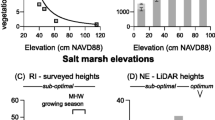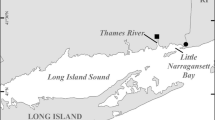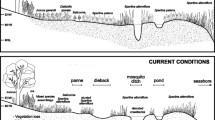Abstract
Separating the effects of anthropogenic changes in freshwater delivery from that of sea level rise on the rate of salt water encroachment in the low relief Southeast Saline Everglades is important for understanding how the Anthropocene Marine Transgression might be best managed. We use stratigraphic and paleoecologic methods to calculate rates of salt water encroachment and biogenic sediment accumulation in the Southeast Saline Everglades. Our results suggest that sea level rise during the last century was accompanied by salt water encroachment, which is ultimately controlled by the elevation of high tide and varied by a factor of 14.8 in the five watersheds studied. These differences are attributed primarily to differences in freshwater delivery. The delivery of freshwater mitigated salt water encroachment in only one of the five watersheds. This difference is attributed to sufficient freshwater delivery to maintain a plant community with more rapid rate of sediment accumulation than other sites. Under conditions of diminishing freshwater availability and increasing rate of sea level rise, our data suggest that little can be done at a scale large enough to prevent loss of the Southeast Saline Everglades within the next 50–200 years.







Similar content being viewed by others
References
Abbott, R. T., 1974. American Seashells: The Marine Molluska of the Atlantic and Pacific Coasts of North America, 2nd ed. Van Nostrand Reinhold, New York.
Alongi, D. M., F. Tirendi & B. F. Clough, 2000. Below-ground decomposition of organic matter in forests of the mangroves Rhizophorastylosa and Avicenniamarina along the arid coast of Western Australia. Aquatic Botany 68: 97–122.
Appleby, P. G. & F. Oldfield, 1992. Applications of lead-210 to sedimentation studies. In Ivanovich, M. & R. S. Harmon (eds), Uranium-series disequilibrium: applications to earth, marine, and environmental sciences, 2nd ed. Clarendon Press, Oxford: 732–783.
Blinn, D. W., 1993. Diatom community structure along physiochemical gradients in saline lakes. Ecology 74: 1246–1263.
Browder, J. A., R. Alleman, S. Markley, P. Ortner & P. A. Pitts, 2005. Biscayne Bay conceptual ecological model. Wetlands 25: 854–869.
Cahoon, D. R. & J. C. Lynch, 1997. Vertical accretion and shallow subsidence in a mangrove forest of southwestern Florida, USA. Mangroves and Salt Marshes 1: 173–186.
Callaway, J. C., R. D. DeLaune & W. H. Patrick Jr., 1997. Sediment accumulation rates from four coastal wetlands along the Gulf of Mexico. Journal of Coastal Research 13: 181–191.
Castañeda-Moya, E., R. R. Twilley, V. H. Rivera-Monroy, K. Zhang, S. E. Davis & M. Ross, 2010. Sediment and nutrient deposition associated with Hurricane Wilma in mangroves of the Florida Coastal Everglades. Estuaries and Coasts 33: 45–58.
Castañeda-Moya, E., R. R. Twilley, V. H. Rivera-Monroy, B. D. Marx, C. Coronado-Molina & S. M. Ewe, 2011. Patterns of root dynamics in mangrove forests along environmental gradients in the Florida Coastal Everglades, USA. Ecosystems 14: 1178–1195.
Chambers, L. G., S. E. Davis, T. G. Troxler & J. A. Entry, 2015. Sea level rise in the Everglades: plant-soil-microbial feedbacks in response to changing physical conditions. In Entry, J. A., A. D. Gottlieb, K. Jayachandran & A. Ogram (eds), Microbiology of the Everglades Ecosystem. CRC Press, Boca Raton: 89–112.
Chen, R. & R. R. Twilley, 1999. Patterns of mangrove forest structure and soil nutrient dynamics along the Shark River estuary, Florida. Estuaries 22: 955–970.
Church, J. A. & N. J. White, 2011. Sea-level rise from the late 19th to the early 21st century. Surveys in Geophysics 32: 585–602.
Cohen, A. D. & W. Spackman, 1974. The phytogenic organic sediments and sedimentary environments in the Everglades-mangrove complex. Part II. Palaentographica 162: 71–114.
Craighead Jr., F. C., 1964. Land, mangroves and hurricanes. Fairchild Tropical Garden, Miami.
Craighead Jr., F. C., 1966. Additional considerations of the experimental closing of the culverts along the Flamingo Road. Technical Report, National Park Service.
Craighead Jr., F. C. & V. C. Gilbert, 1962. The effects of Hurricane Donna on the vegetation of southern Florida. Quarterly Journal of the Florida Academy of Sciences 25: 1–28.
Cutshall, J. C., I. R. Larsen & C. R. Olsen, 1983. Direct analysis of Pb210 in sediment samples: self-absorption corrections. Nuclear Instruments and Methods 206L: 309–312.
Davis, J. H., Jr., 1940. The ecology and geologic role of mangroves in Florida. Papers Tortugas Laboratory, Carnegie Institute, Washington, Publication No. 517: 304–412.
Davis Jr., J. H., 1946. The peat deposits if Florida. Florida Geological Survey Bulletin 25: 1–311.
Davis III, S. E., J. E. Cable, D. L. Childers, C. Coronado-Molina, J. W. Day Jr., C. D. Hittle, C. J. Madden, E. Reyes, D. Rudnick & F. Sklar, 2004. Importance of storm events in controlling ecosystem structure and function in a Florida gulf coast estuary. Journal of Coastal Research 20: 1198–1208.
Dean Jr., W. E., 1974. Determination of carbonate and organic matter in calcareous sediments and sedimentary rocks by loss on ignition: comparison and other methods. Journal Sedimentary Petrology 44: 242–248.
DeLaune, R. D., I. Devai, C. R. Crozier & P. Kelle, 2002. Sulfate reduction in Louisiana marsh soils of varying salinities. Communications in soil science and plant analysis 33: 79–94.
Dévai, I. S. T. V. Á. N., K. R. Reddy, R. D. DeLaune & D. A. Graetz, 1996. Sulfate reduction and organic matter decomposition in a wetland soil and lake sediment. Acta Biologica Debrecina Supplementum Ecologica Hungarica 6: 13–23.
Duever, M. J., J. E. Carlson, J. F. Meeder, L. C. Duever, L. H. Gunderson, L. A. Riopelle, T. R. Alexander, T. R. Myers & D. P. Spangler, 1986. The big cypress national preserve. National Audubon Society Research Report 8: 1–455.
Duever, M. J., J. F. Meeder, L. B. Meeder & J. M. McCollom, 1994. The climate of South Florida and its role in shaping the Everglades Ecosystem. In Davis, S. M. & J. C. Ogden (eds), Everglades: The Ecosystem and its Restoration. St. Lucie Press, Delray Beach: 225–248.
Ellison, J. C., 1993. Mangrove retreat with rising sea-level, Bermuda. Estuarine, Coastal and Shelf Science 37: 75–87.
Ellison, J. C. & D. R. Stoddart, 1991. Mangrove ecosystem collapse during predicted sea-level rise: Holocene analogues and implications. Journal of Coastal Research 7: 151–165.
Egler, F. E., 1952. Southeast saline Everglades vegetation, Florida, and its management. Plant Ecology 3: 213–226.
Ezer, T., 2013. Sea level rise, spatially uneven and temporally unsteady: why the US East Coast, the global tide gauge record, and the global altimeter data show different trends. Geophysical Research Letters 40: 5439–5444.
Friedman, G. M., 1959. Identification of carbonate minerals by staining methods. Journal of Sedimentary Research 29: 87–97.
Gleason, P., 1972. The origin, sedimentation, and stratigraphy of a calcitic mud located in the southern fresh-water Everglades. Ph.D. Dissertation, Pennsylvania State University, University Park.
Gleason, P. J. & P. A. Stone, 1994. Age, origin, and landscape evolution of the Everglades peatland. In Davies, S. M. & J. C. Ogden (eds), Everglades: The Ecosystem and its Restoration. St Lucie Press, Delray Beach: 149–198.
Gleason, P. J. & W. Spackman, Jr., 1974. Calcareous periphyton and water chemistry in the Everglades. In Gleason, P.J. (ed.), Environments of South Florida: Present and Past. Miami Geological Society Memoir 2: 146–181.
Gleason, P. J., A. D. Cohen, W. G. Smith, H. K. Brooks, P.A. Stone, R. L. Goodrick & W. Spackman, Jr., 1974. The environmental significance of Holocene sediments from the Everglades and saline tidal plain. In Gleason, P. J. (ed.), Environments of South Florida: Present and Past. Miami Geological Society Memoir 2:287–341.
Hay, C. C., E. Morrow, R. E. Kopp & J. X. Mitrovica, 2015. Probabilistic reanalysis of twentieth-century sea-level rise. Nature Climate Change 517: 481–484.
Huxham, M., J. Langat, F. Tamooh, H. Kennedy, M. Mencuccini, M. W. Skov & J. Kairo, 2010. Decomposition of mangrove roots: effects of location, nutrients, species identity and mix in a Kenyan forest. Estuarine, Coastal and Shelf Science 88: 135–142.
IPCC, 2013. Summary for policymakers. In Stocker T, Qin D et al. (eds). Climate change 2013: the physical science basis. Contribution of Working Group I to the Fifth Assessment Report of the Intergovernmental Panel on Climate Change. Cambridge University Press, Cambridge, United Kingdom and New York, NY, USA [available on internet at https://www.ipcc.ch/report/ar5/wg1/]. Accessed 20 Feb 2014.
Jones, L. A., 1948. Soils, geology, and water control in the Everglades region. University of Florida Agricultural Experimental Station Bulletin 442: 1–168.
Koch, M. S., 1997. Rhizophora mangle L. Seedling Development into the Sapling Stage across Resource and Stress Gradients in Subtropical Florida. Biotropica 29: 427–439.
Kotun, K. & A. Renshaw, 2014. Taylor Slough hydrology. Wetlands 34: 9–22.
Krairapanond, N., R. D. DeLaune & W. H. Patrick, 1991. Seasonal distribution of sulfur fractions in Louisiana salt marsh soils. Estuaries and Coasts 14: 17–28.
Krauss, K. W., C. E. Lovelock, K. L. McKee, L. López-Hoffman, S. M. Ewe & W. P. Sousa, 2008. Environmental drivers in mangrove establishment and early development: a review. Aquatic Botany 89: 105–127.
Ladd, H. S., 1957. Paleoecological evidence. In Ladd, H. S. (ed.), A treatise on marine Ecology and paleoecology. Geological Society of America Memoirs 67: 599–640.
Leach, S. D., H. Klein & E. R. Hampton, 1972. Hydrologic effects of water control and management of southeastern Florida. Florida Bureau of Geology, Report of Investigations 60: 1–115.
Lynch, J. C., J. R. Meriwether, B. A. McKee, F. Ver-Herrera & R. R. Twiley, 1989. Recent accretion in mangrove ecosystems based on Cs137 and Pb210. Estuaries 12: 284–299.
Maul, G. A. & D. M. Martin, 1993. Sea level rise at Key West, Florida, 1846–1992: America’s longest instrument record? Geophysical Research Letters 20: 1955–1958.
McIvor, A. L., T. Spencer, I. Möller & M. Spalding, 2013. The response of mangrove sediment surface elevation to SLR. The Nature Conservancy and Wetlands International, Natural Coastal Protection Series: Report 3. Cambridge Coastal Research Unit Working Paper 42: 1–59.
McKee, K. L., D. R. Cahoon & I. C. Feller, 2007. Caribbean mangroves adjust to rising sea level through biotic controls on change in soil elevation. Global Ecology and Biogeography 16(5): 545–556.
McVoy, C. W., W. P. Said, J. Obeysekera, J. A. Van Arman & T. W. Dreschel, 2011. Landscapes and hydrology of the predrainage Everglades. University Press of Florida, Gainesville.
Meeder, J. F., M. S. Ross, G. Telesnicki, P. L. Ruiz, & J. P. Sah, 1996. Vegetation Analysis in the C-111/Taylor Slough Basin. In two parts: (1) Document One, The Southeast Saline Everglades revisited: a half century of coastal vegetation change; (2) Document Two, Marine Transgression in the southeast Saline Everglades, Southeast Environmental Research Center Research Report 6 [available on internet at http://digitalcommons.fiu.edu/sercrp/6].
Middleton, B. A. & K. L. McKee, 2001. Degradation of mangrove tissues and implications for peat formation in Belizean island forests. Journal of Ecology 89: 818–828.
Moore, D. R., 1964. Mollusca of the Mississippi coastal waters. Gulf Coast Bulletin 1.
NASA, 2016. Global Climate Change: Vital Signs of the Planet [available on internet at http://climate.nasa.gov/vital-signs/sealevel/].
Nicholls, R. J. & A. Cazenave, 2010. Sea-Level Rise and Its Impact on Coastal Zones. Science 328: 1517–1520.
NOAA, 2012. CO2 data of US National Oceanic and Atmospheric Administration [available on internet at ftp://ftp.cmdl.noaa.gov/ccg/co2/trends/co2_annmean_gl.txt].
Odum, W. E., C. C. McIvor & T. J. Smith, III, 1982. The ecology of the mangroves of South Florida: A community profile. FWS/OBS-81/24: 1–145.
Park, J. & W. V. Sweet, 2015. Accelerated sea level rise and Florida Current transport. Ocean Science 11: 607–615.
Parker, G. G., G. E. Ferguson & S. K. Love, 1955. Water resources of southeastern Florida with special reference to the geology and ground water of the Miami area. United States Geological Survey Water-Supply Paper 1255: 1–965.
Parkinson, R. W., 1989. Decelerating Holocene SLR and its influence on southwest Florida coastal evolution: a transgressive-regressive stratigraphy. Journal of Sedimentary Petrology 59: 960–972.
Parkinson, R. W. & J. F. Meeder, 1991. Mud-bank destruction and the formation of a transgressive sand sheet, southwest Florida inner shelf. Geology Society of America Bulletin 103: 1543–1551.
Parkinson, R. W., R. D. DeLaune & J. R. White, 1994. Holocene sea-level rise and the fate of mangrove forests within the wider Caribbean region. Journal of Coastal Research 10: 1077–1086.
Parkinson, R. W., P. W. Harlem & J. F. Meeder, 2015. Managing the Anthropocene Marine Transgression to the 2100 and beyond in the State of Florida USA. Climatic Change 128: 83–98.
Perry, W., 2004. Elements of south Florida’s comprehensive Everglades restoration plan. Ecotoxicology 13: 185–193.
Poret, N., R. R. Twilley, V. H. Rivera-Monroy & C. Coronado-Molina, 2007. Belowground decomposition of mangrove roots in Florida coastal Everglades. Estuaries and Coasts 30: 491–496.
Rohling, E. J., I. D. Haigh, G. L. Foster, A. P. Roberts & K. M. Grant, 2013. A geological perspective on potential future sea-level rise. Scientific Reports 3. doi:10.1038/srep03461.
Ross, M. S., J. F. Meeder, J. P. Sah, P. L. Ruiz & G. J. Telesnicki, 2000. The southeast saline Everglades revisited: 50 years of coastal vegetation change. Journal of Vegetation Science 11: 101–112.
Ross, M. S., E. E. Gaiser, J. F. Meeder & M. T. Lewin, 2002. Multi-taxon analysis of the “white zone”, a common ecotonal feature of South Florida coastal wetlands. In Porter, J. W. & K. G. Porter (eds), The Everglades, Florida Bay and Coral Reefs of the Florida Keys. CRC Press, Boca Raton: 205–238.
Ross, M. S., J. F. Meeder, E. Gaiser, P. L. Ruiz, J. P. Sah, D. L. Reed, J. Walters, G. T. Atlas, A. Telesnicki, M. Wachnicka, J. Jacobson, J. Alvord, M. Byrnes, C. Weekley, M. T. Lewin, B. Fry & A. Renshaw, 2003. The L-31E Surface Water Rediversion Project Final Report: Implementation, Results, and Recommendations. Southeast Environmental Research Center Research Report 1 [available on internet at http://www.digitalcommons.fiu.edu/sercrp/1].
Scholl, D. W., F. C. Craighead & M. Stuiver, 1969. Florida submergence curve revised: its relation to coastal sedimentation rates. Science 163: 562–564.
Spackman, W., A. D. Cohen, P. H. Given & D. J. Casagrande, 1976. A field guidebook to aid in the comparative study of the Okefenokee Swamp and the Everglades-mangrove swamp-marsh complex of southern Florida. A short course presentation, June 1976, Coal Research Section, The Pennsylvania State University (No. 6).
Tabb, D. C. & R. B. Manning, 1961. A checklist of the flora and fauna of northern Florida Bay and adjacent brackish waters of the Florida mainland collected during the period July 1957 through September 1960. Bulletin Marine Science 1: 550–647.
Thompson, F. G., 1984. Freshwater Snails of Florida: A Manual for Identification. University of Florida Press, Gainesville, FL.
Turney, W. J. & B. F. Perkins, 1972. Molluscan distribution in Florida Bay. Comparative Sedimentology Laboratory, Sedimenta III: 1–37.
Vlaswinkel, B. M. & H. R. Wanless, 2012. Rapid recycling of organic-rich carbonates during transgression: a complex coastal system in southwest Florida. Perspectives in Carbonate Geology: A Tribute to the Career of Robert Nathan Ginsburg. International Association of Sedimentologists Special Publication 41(98): 91–112.
Wanless, H. R., 1974. Mangrove sedimentation in geological perspective. In Gleason, P.J. (ed.), Environments of South Florida: Present and Past. Miami Geological Society Memoir 2: 190–200.
Wanless, H. R., R. Parkinson & L. Tedesco, 1994. Sea level control on stability of Everglades wetlands. In Davis, S. & J. Ogden (eds), The Florida Everglades: the Ecosystem and its Restoration. St Lucie Press, Delray Beach: 199–224.
Wdowinski, S., R. Bray, B. P. Kirtman & Z. Wu, 2016. Increasing flooding hazard in coastal communities due to rising sea level: case study of Miami Beach, Florida. Ocean & Coastal Management 126: 1–8.
Whelan, K. R., T. J. I. Smith III, D. R. Cahoon, J. C. Lynch & G. H. Anderson, 2005. Groundwater control of mangrove surface elevation: shrink and swell varies with soil depth. Estuaries 28: 833–843.
Whelan, K. R., T. J. Smith III, G. H. Anderson & M. L. Ouellette, 2009. Hurricane Wilma’s impact on overall soil elevation and zones within the soil profile in a mangrove forest. Wetlands 29: 16–23.
Woodroffe, C. D., 1981. Mangrove swamp stratigraphy and Holocene transgression, Grand Cayman Island, West Indies. Marine Geology 41: 271–294.
Woodroffe, C. D., 1995. Response of tide dominated mangrove shorelines in Northern Australia to anticipated sea level rise. Earth Surface Processes and Landforms 20: 65–85.
Acknowledgements
We would like to thank the SFWMD for funding the C-111 study (C-4244), L31E Pilot Project (C-12409), the Historic Creek Study (SFWMD 11679), and the Black Point Rehydration project (SFWMD x204114). Thanks to Gordon Anderson for providing elevation data for the Highway Creek and Joe Bay sites without recorders, Dr. Jerry Lorenz for providing elevation estimates, and Dr. Robert Fennema for providing contour maps of the western SESE. Special thanks to Dr. R.E. Turner for providing sediment accretion data. All Supporting Data are published as Electronic Supplementary Material. This is SERC Publication # 841.
Author information
Authors and Affiliations
Corresponding author
Additional information
Guest editors: K. W. Krauss, I. C. Feller, D. A. Friess, R. R. Lewis III / Causes and Consequences of Mangrove Ecosystem Responses to an Ever-Changing Climate
Electronic supplementary material
Below is the link to the electronic supplementary material.
Rights and permissions
About this article
Cite this article
Meeder, J.F., Parkinson, R.W., Ruiz, P.L. et al. Saltwater encroachment and prediction of future ecosystem response to the Anthropocene Marine Transgression, Southeast Saline Everglades, Florida. Hydrobiologia 803, 29–48 (2017). https://doi.org/10.1007/s10750-017-3359-0
Received:
Revised:
Accepted:
Published:
Issue Date:
DOI: https://doi.org/10.1007/s10750-017-3359-0




